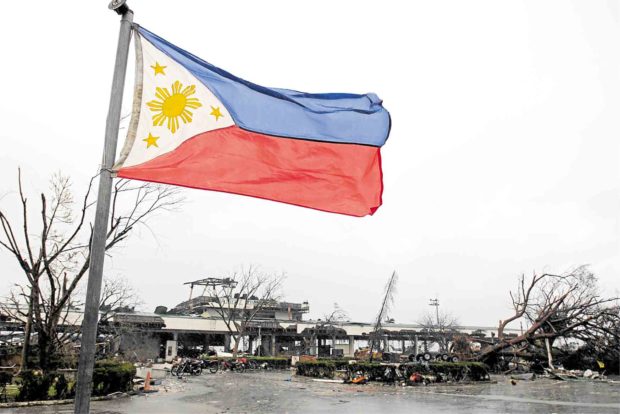Hope and heartbreak in ‘Yolanda’ country

PAINFUL YET INSPIRING A Philippine flag, surprisingly intact, waves proudly over the desolate post-Yolanda landscape in Leyte. —NIÑO JESUS ORBETA
How do journalists steel themselves against the onslaught of emotion when writing about calamities? I was about to find out.
Six years ago, I was part of the Inquirer team sent to cover the devastation wrought by Supertyphoon “Yolanda” (international name: Haiyan) on Eastern Visayas.
Around 5 a.m. on Nov. 8, 2013, supertyphoon Yolanda slammed into the country’s eastern seaboard with maximum winds and gustiness of 275 kilometers per hour, and with storm surges as high as a two-story building. It flattened trees, demolished homes and peeled roofs off concrete structures. Some 6,300 lives were lost, and the damage was estimated at P95.5 billion.
For 12 days, our team of three—myself, photographer Richard Balonglong and driver Marvin Isorena—covered Yolanda’s impact on the province, scouring the desolate landscape for stories of loss and survival.
The coverage was a physical and logistical challenge, but the tougher test for me was to try not to be overwhelmed by the magnitude of human suffering in the aftermath of a natural disaster.
Article continues after this advertisementThe sight was heartbreaking. It was like watching a surreal, postapocalyptic movie. Thousands of downed coconut trees pierced the sky like candlesticks unevenly thrust into the ground. Chaos ruled, the roads were littered with soiled clothes and other debris, while the residents were reduced to being scavengers.
Article continues after this advertisementOur most immediate problem was transmitting the news. We were in unknown territory, and knew absolutely no one from the place. The supertyphoon had downed all power lines, plunging the whole Visayas regions in total darkness.
Out on the road, our coverage was a virtual jungle survival. Only a few food establishments remained open for business, and we had to make do with our meager supply of biscuits, Cloud 9 chocolates and bottled water.
At day’s end, after an exhausting 18 hours of news coverage, we would spend our remaining strength joining the kilometric queue of people at public charging stations in Tacloban City Hall and the provincial capitol in Borongan to recharge our equipment.
If there was one easy part in our coverage, it was encountering possible subjects of interview at every turn. Everyone we met on the road was a survivor, who always had an interesting story to tell.
The worst part was coming face-to-face with the typhoon victims, listening to their stories, watching them silently weep and grieve over their lost loved ones and property, and feeling helpless to offer comfort beyond a gentle tap on their shoulders.
It was heart-wrenching to see children and sometimes adults like 50-year-old Norma Saliwan line up on the roadside in Quinapondan town, with handwritten placards begging for food and water. And yet, we were often unable to stop and give them their immediate needs.
One morning while on coverage in remote Gigoso village in Giporlos town, our team came across a family of four, who appeared to be stuck under their flattened hut near the village road. They’re sick, they told us, and did not have the strength to get out of their home, much less walk to the village center for relief goods. We ended up giving our supply of biscuits, noodles and medicines to the family.
It was painful, yet inspiring, to see Filipinos trying to rise above adversity and rebuilding shattered lives from whatever was left them by the supertyphoon.
Reaching home after 12 days in Yolanda country, I tried to compose a story to cap off our coverage. The memories of the people left bereft of hope in Eastern Samar came rushing back. I wondered how the orphaned children would make it through each day. Would their smiles eventually wear off?
For the first time in my life as a journalist, I found myself weeping over my copy.